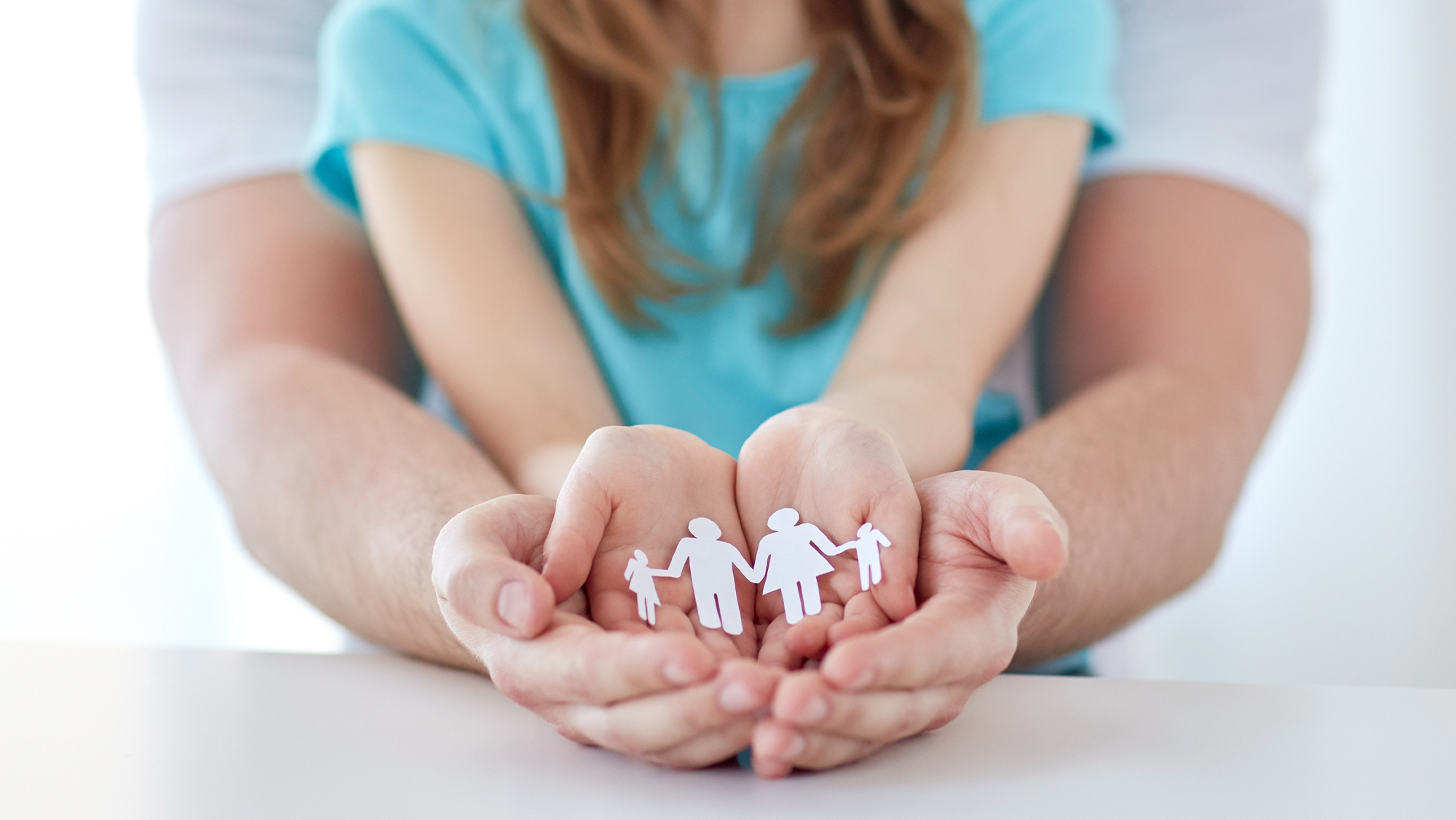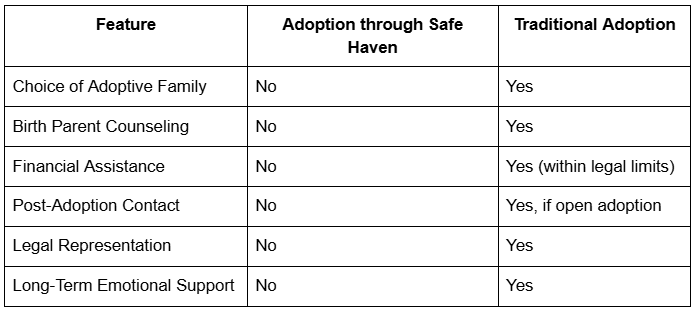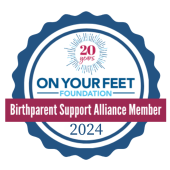
Every birth parent facing an unexpected pregnancy deserves real options, clear information, and compassion. For some, placing a baby for adoption feels overwhelming enough, but knowing which adoption path to take can add even more confusion.
Adoption through Safe Haven and traditional adoption both offer paths to provide a loving home for a baby. But these two options are very different when it comes to support, long-term impact, and the protections they offer to birth parents.
In this article, we’ll talk openly about both, not to compare them harshly, but to provide clarity. Because when it comes to adoption, having all the facts matters.
What Is Adoption through Safe Haven?
Adoption through Safe Haven exists because sometimes parents find themselves in situations they never expected: scared, overwhelmed, and unsure where to turn. That’s exactly why Safe Haven Laws were created. These laws, which exist in every U.S. state, offer a safe and legal option for birth parents in crisis to make sure their baby is protected.
Maybe you’ve wondered if there’s any help for a parent who feels completely alone and unable to care for their newborn. Safe Haven Laws allow a parent to safely surrender their baby, usually within a certain timeframe after birth (which varies by state), without facing legal trouble. For parents in an extreme crisis, it can feel like the only way to keep their child safe when parenting isn’t possible in that moment.
Safe Haven Awareness Month
Every April, we recognize Safe Haven Awareness Month, a time to educate, raise awareness, and remind birth parents that safe, legal options are available when they feel overwhelmed or alone. This month matters deeply to us because we know how important it is for parents in crisis to feel supported, not judged. No one should ever have to face such a difficult situation without knowing where to turn.
At the Adoption Center for Family Building, we use Safe Haven Awareness Month to share accurate information, offer guidance, and make sure birth parents know they’re never truly alone. Our goal is simple: to help every parent understand their options, feel cared for, and know that help is always available when they need it most.
Why Some Parents Consider Adoption through Safe Haven
- In an unsafe or abusive situation
- Afraid of family judgment
- Without resources or housing
- Facing mental health struggles
- Feeling overwhelmed right after birth
These are situations no parent should face alone. But Safe Haven Laws step in to offer immediate protection, for both the baby and the birth parent.
Still, it’s important to know that help exists beyond Safe Haven Adoption.
How Traditional Adoption Works
While Adoption through Safe Haven offers legal protection, traditional adoption involves working directly with a licensed adoption agency or attorney. This process provides birth parents with extensive support and guidance from the very beginning.
In traditional adoption, birth parents can:
- Choose the adoptive family
- Create an adoption plan
- Receive emotional and counseling support
- Have ongoing communication (in open adoptions)
- Access resources like medical care and legal advice
Comparing Support - Safe Haven vs Traditional Adoption

Why Working with an Adoption Agency Matters
Working with an agency like the Adoption Center for Family Building gives birth parents the chance to stay involved, supported, and cared for throughout the process. Instead of surrendering anonymously, parents can find comfort in knowing their child’s future.
Traditional adoption also ensures:
- Legal clarity
- Counseling before and after placement
- The ability to receive updates or visits (if desired)
- A chance to create a loving, thoughtful adoption plan
Legal Differences to Understand
Legal Protections in Adoption through Safe Haven
- The child must be a certain age (usually under 30 days old)
- The child must be left at an approved Safe Haven location
- The surrender must happen face-to-face with the staff
- The parent remains anonymous (unless they choose otherwise)
Once the child is safely surrendered, custody is typically transferred to child welfare services, and the baby is placed into the foster care or adoption system.
But it’s important to understand that in most states, the birth parent gives up all parental rights immediately and permanently when surrendering under Safe Haven Laws. There is usually no way to reclaim parental rights afterward.
Legal Process in Traditional Adoption
Traditional adoption looks very different from a legal standpoint. When working with a licensed agency like the Adoption Center for Family Building, the process respects and protects both the baby and the birth parents.
Some key legal protections for birth parents in traditional adoption include:
- Time to consider their options
- Legal representation to explain their rights
- The ability to create an adoption plan
- A consent process that is informed and voluntary
- The opportunity for post-adoption communication agreements
The Emotional Side of Adoption No One Talks About
Choosing adoption is never easy. It comes with so many emotions: love, fear, heartbreak, and hope, often all at the same time. For birth parents, the experience can feel very different depending on the path they take. Adoption through Safe Haven is often chosen in moments of fear or crisis. It can bring quick relief knowing a baby is safe, but that relief is sometimes mixed with sadness, guilt, or wondering what their child’s future might look like. And because Safe Haven is anonymous, many parents are left to cope with those heavy feelings alone, without support or connection after placement.
Traditional adoption tends to feel more personal and supported. Working with an agency like the Adoption Center for Family Building gives birth parents the chance to ask questions, meet the adoptive family, and stay involved in a way that feels right for them. It’s a path built on care, respect, and connection, not just during placement, but long after, as parents continue to heal and find peace with their decision.
The Child’s Future Connection to Birth Family
One of the biggest differences between Safe Haven adoption and traditional adoption is the possibility for a child to have a future connection with their birth family. In Adoption through Safe Haven, babies are often placed without any identifying information about their birth parents. This means they may grow up without access to family medical history, the ability to ask personal questions later in life, or any updates about their birth family. While these children are absolutely placed into loving adoptive homes, their connection to their biological family is typically closed permanently, which can sometimes lead to identity challenges as they grow older.
Traditional adoption offers a very different experience. Birth parents working with an agency have the choice to leave important information for their child, things like medical history, personal letters, or even the opportunity for future contact. Some adoptions may include photos, video calls, or in-person visits, depending on what everyone feels comfortable with. This openness allows adopted children to have answers to their questions and develop a stronger sense of identity and belonging as they move through life.
Why Traditional Adoption Is Often the Better Choice
Safe Haven adoption has a very specific purpose, to protect newborns in immediate danger and to give birth parents in crisis a safe, legal option.
But for those who have time, resources, or support, traditional adoption is almost always a better choice for both the birth parent and the child.
Traditional adoption offers:
- Emotional support
- Legal protection
- The ability to choose the adoptive family
- Ongoing contact if desired
- Counseling and resources
- A safe, loving plan made with care
Support Is Always Available
No birth parent should feel pressured, rushed, or alone when considering adoption. Even if pregnancy feels overwhelming or scary, help is available. Adoption through Safe Haven provides immediate safety, but traditional adoption provides long-term care and support.
At the Adoption Center for Family Building, we’re here to walk with you through every step, offering guidance, compassion, and a plan that feels right for you and your baby.
Deciding Between Adoption through Safe Haven and Traditional Adoption
Both Safe Haven adoption and traditional adoption exist to protect babies and offer options to birth parents. But while Safe Haven Laws provide critical emergency protection, working with an adoption agency like the Adoption Center for Family Building gives parents the care, resources, and emotional support they deserve.
Every situation is unique. But when given time, information, and help, many birth parents find that traditional adoption offers the connection, peace, and love they’re hoping for, both for themselves and their child.
If you’re considering adoption and want to understand your options beyond Adoption through Safe Haven, we invite you to reach out. Our caring team is here to listen, support, and help you create a thoughtful plan for you and your baby.
Visit the Adoption Center for Family Building to learn more, or contact us directly to speak with someone who truly cares. No pressure, no judgment, just help when you need it most.



